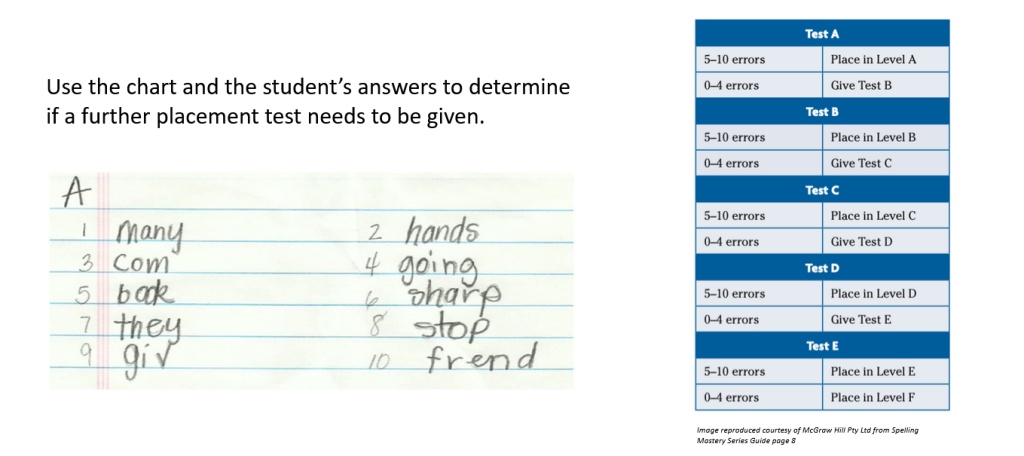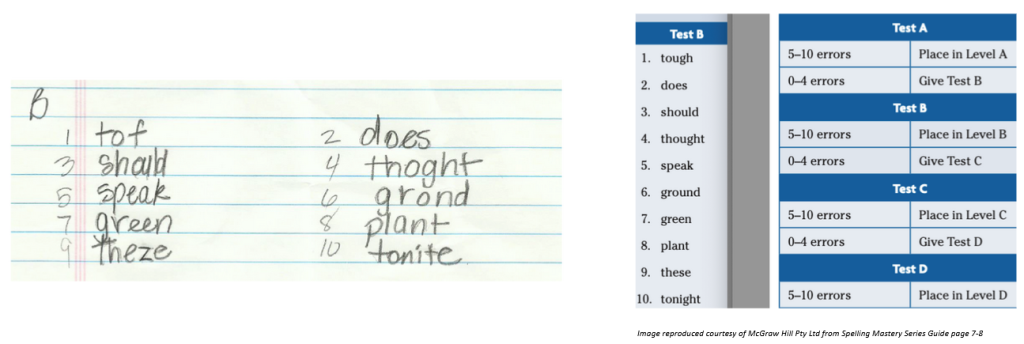Teach Spelling Mastery A-F
-
Module Introduction5 Topics
-
Overview18 Topics|3 Tests
-
Cover
-
Lesson Objective
-
Opening the Lesson
-
Spelling Mastery Training
-
Teach to Mastery
-
Whole-Word Approach
-
Phonemic Approach
-
Morphemic Approach
-
Check Your Understanding
-
Teaching Materials
-
Level A–F student workbooks
-
Teach in Tracks
-
Video – Spelling Mastery in Action
-
Check Your Understanding
-
Video – Arthur S talks about Spelling Mastery
-
Test Your Understanding
-
Review
-
Lesson Completed
-
Cover
-
Using Program Materials and Organising the Classroom16 Topics|3 Tests
-
Cover
-
Lesson Objective
-
Opening the Lesson
-
Placement Tests
-
Determine Levels
-
Give the Placement Test
-
Video – Spelling Mastery Placement Test
-
Placement Criteria
-
Check Your Understanding
-
Case Study
-
Organise the Space
-
Video – Active monitoring
-
Check Your Understanding
-
Test Your Understanding
-
Review
-
Lesson Completed
-
Cover
-
Teacher Resources16 Topics|3 Tests
-
Cover
-
Lesson Objective
-
Opening the Lesson
-
The Script
-
Features of a Script
-
Delivering a Script
-
Video – Spelling Mastery A Lesson 18, Exercise 3
-
Check Your Understanding
-
Teacher’s Guide
-
Series Guide
-
Questions and answers
-
Check Your Understanding
-
Video – Spelling Mastery Use of Series Guide and Teacher’s Guide
-
Test Your Understanding
-
Review
-
Lesson Completed
-
Cover
-
Signalling15 Topics|3 Tests
-
Cover
-
Lesson Objective
-
Opening the Lesson
-
Signals Rationale
-
Parts of a Signal
-
Auditory signal
-
Video – Auditory signal
-
Check Your Understanding
-
High Standards
-
Practice Makes Perfect
-
Video – Examples and Non Examples of Signalling
-
Check Your Understanding
-
Test Your Understanding
-
Review
-
Lesson Completed
-
Cover
-
Active Monitoring14 Topics|2 Tests
-
Cover
-
Lesson Objective
-
Opening the Lesson
-
Keep Students on Task
-
Video 8 – Active Monitoring
-
Practise the Tick Mark
-
Evaluate Independent Work
-
Check Your Understanding
-
Rules for Active Monitoring
-
Rules for Active Monitoring continued
-
Video 11 – Spelling Mastery B, lesson 111
-
Test Your Understanding
-
Review
-
Lesson Completed
-
Cover
-
Pacing and Transitions18 Topics|3 Tests
-
Cover
-
Lesson Objective
-
Opening the Lesson
-
Pacing Explained
-
Perky Pace
-
Lesson Delivery
-
Benefits of Perky Pace
-
Video – Spelling Mastery B Lesson 10 exercise 1
-
Check Your Understanding
-
Program Expectations
-
Transitions and Routines
-
Check Your Understanding
-
Video – Effective Transitions
-
Practise Makes Perfect
-
Video – Spelling Mastery B Lesson 111 Pacing and transitions
-
Test Your Understanding
-
Review
-
Lesson Completed
-
Cover
-
Motivating Students20 Topics|3 Tests
-
Cover
-
Lesson Objective
-
Opening the Lesson
-
Direct Instruction
-
Enthusiasm
-
Point Systems
-
Oral Work Guidelines
-
Written Work Guidelines
-
Bonus
-
Check Your Understanding
-
Video – Lisa Brodbeck Talks About Motivation
-
Teacher/Student Game
-
Video – Teacher/Student Game Introduction
-
Game Guidelines
-
Awarding Points
-
Check Your Understanding
-
Video – Teacher Teaching Lesson with Teacher/Student Game
-
Test Your Understanding
-
Review
-
Lesson Completed
-
Cover
-
Individual Turns16 Topics|2 Tests
-
Cover
-
Lesson Objective
-
Opening the Lesson
-
Understanding Individual Turns
-
Present to the Group
-
Procedure
-
Video – Spelling Mastery Exercise with Individual Turns
-
Guidelines
-
Give Every Student an Opportunity
-
Check Your Understanding
-
Tracking Individual Turns
-
Student mastery
-
Video – RMSE K With Individual Turns
-
Test Your Understanding
-
Review
-
Lesson Completed
-
Cover
-
Correcting Errors16 Topics|2 Tests
-
Cover
-
Lesson Objective
-
Opening the Lesson
-
Correcting Errors
-
Types of Student Errors
-
Correction Procedure for Specific Errors
-
Correction Procedure Example
-
Check Your Understanding
-
Scenario of a Teacher Correcting a Response Error
-
Video – Correction Procedure
-
Task-specific Error Corrections
-
Error Correction Practice
-
Video – Model, Lead, Test, Retest
-
Test Your Understanding
-
Review
-
Lesson Completed
-
Cover
-
Correcting General Errors15 Topics|2 Tests
-
Cover
-
Lesson Objective
-
Opening the Lesson
-
General Errors
-
Types of Errors and Correction Procedures
-
Error Correction Example
-
Video – General Error Corrections
-
Check Your Understanding
-
Correction Tips
-
Scenario of Teacher Correcting a General Error
-
Positive Corrective Feedback
-
Video – Providing Positive Corrective Feedback
-
Test Your Understanding
-
Review
-
Lesson Completed
-
Cover
-
Mastery Tests and Data Collection20 Topics|3 Tests
-
Cover
-
Lesson Objective
-
Opening the Lesson
-
Ensuring Understanding
-
Assessing Understanding
-
Reinforcing Understanding
-
Bonus Activity Points
-
Check Your Understanding
-
Video – Spelling Mastery A, Lesson 15, exercises 2 and 3
-
Test Procedure
-
Remedy Retesting
-
Check Your Understanding
-
Video – Giving a mastery test
-
Attendance on SPT
-
Lesson Progress on SPT
-
Record Independent Work
-
Mastery Tests on SPT
-
Test Your Understanding
-
Review
-
Lesson Completed
-
Cover
-
Module Review20 Topics|2 Tests
-
Cover
-
Lesson Objective
-
Opening the Lesson
-
Spelling Mastery Overview
-
Student Placement
-
Teaching Script
-
Auditory Signal
-
Video – Auditory Signal
-
Check Your Understanding
-
Active Monitoring
-
Video – Active Monitoring
-
Perky Pacing
-
Behaviour Management
-
Individual Turns
-
Error Correction
-
Regular Assessment
-
Video – Spelling Mastery B, Lesson 106
-
Test Your Understanding
-
Review
-
Lesson Completed
-
Cover
-
Module evaluation survey1 Topic

Case Study
A year four student, whose spelling instruction in the past has been based on word lists determined by the teacher at another school has been placed in the Corrective Reading Decoding B1 program.
This student does not enjoy writing assignments and writes short narratives. They ask for help to spell words frequently and have many misspellings in their writing. They are hesitant to write answers in workbooks and frequently ask for help with spelling.
Given what is known about this student, the teacher starts by giving them placement test A.

The student made three errors on placement test A, so the teacher needs to administer placement test B.

The teacher then checks if they need to give placement test C to the student.
They do not give placement test C due to the six errors the student made which places them in level B.
The teacher places the student in a group with other students beginning Spelling Mastery Level B.
This student has now been placed homogeneously – meaning they are placed at their correct level for learning.
Grouping students homogeneously by program level enables teachers to set the students up for success.

